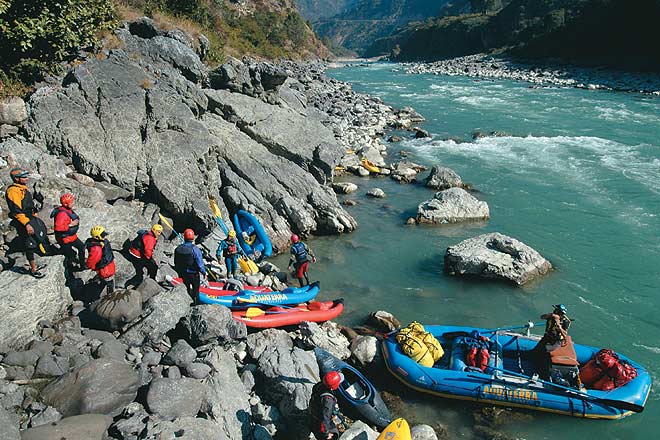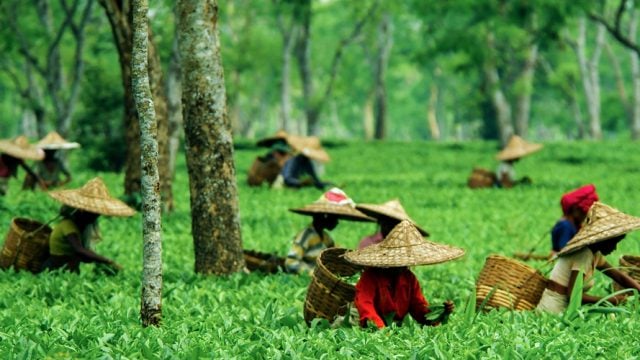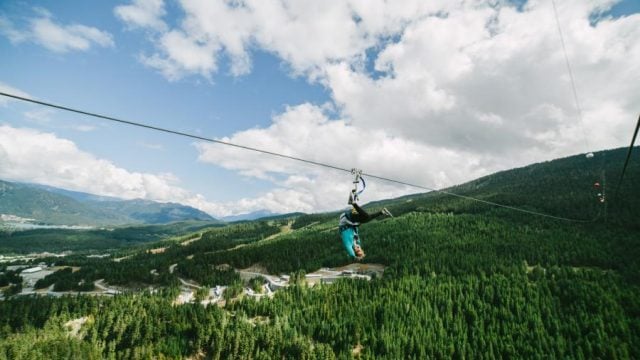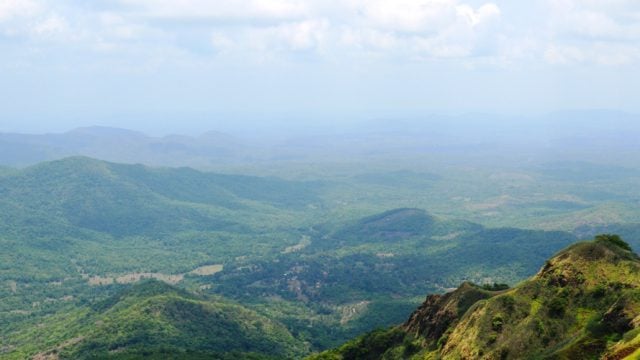I’d had serious second thoughts. If it was this miserably cold in Delhi, what would a Himalayan
I’d boarded the train all set to slink home if the training session went poorly. So it was a triumph to be standing at Rudraprayag, the put-in point for the expedition, wearing thermals under a wetsuit, neoprene footwear and gloves, a splash jacket, a helmet over a peaked cap over a swimming cap, and a life jacket. I was sooo equipped.
Then I examined the water boiling around the confluence of the Mandakini and Alaknanda rivers, and knew my confidence for the vastly stupid thing it was. Holy Hole — a big rock over which the river cascades, generating an enormous backlash of a wave — is a Class 4 rapid and I was deeply relieved when we were asked to begin downstream of it. The safety kayakers rode the duckies through while I frantically reviewed the previous afternoon at Camp Silver Sands.
We’d lined up for a primer conducted by our guide, Anvesh, and the other safety kayakers. They’d taught us about ferry angles to cross the river, about main flows and eddies, how to steer and paddle efficiently, what to do if (when) we fell into the river, and so forth. It was reassuring. Duckies are quite easy to handle and the wetsuits took the edge off the water. All in all the hardest part of the session had been hauling the duckies out of the river and up to the road. But it didn’t take a rocket scientist to see that Holy Hole was beyond us.
Downstream, I climbed into a ducky with my husband Milan behind me and off we went: four IKs manned by clients, five safety kayakers bobbing around like nannies, and equipment following on a raft and a cataraft.
You sit closer to the river on a ducky than on a raft, so you get wetter and have a scarier view of the water. The 15km stretch to our first night halt was easy stuff, relatively small Class 1 and 2 rapids, but as we neared the first frothing licks I thought Dear God, I’m not ready, I need more time, should we talk about this? — and then we were in it, bumpety-bumping our way through electrifying glacial sprays with no time to think about anything except following the line the guide was taking through the water.
We were soaked, but I worried much less about the odd splash than about falling in. The smallish rapids were a wonderful training ground for balance, angle and resistance to cold. The trick is to punch through oncoming waves with your bow at 90 degrees, rather than at an angle that might tip you over. The trick to the flat stretches is coordinated movements and endurance. Over the next two hours Milan paddled and steered while I huffed and puffed through my own strokes in the front, fondly remembering all the pushups I hadn’t done in ten years.
We were gaining confidence quickly and soaked in the dramatic Garhwal mountainscape: blue sky, green hills, sparkling water — nature at its pristine best. It was just as well that, coming through a fair-sized rapid, the ducky behind us suddenly flipped off a big wave; the river swept any incipient complacency away along with those two cold-shocked faces.
We were running slightly late. When the sun disappeared around 3.30pm, a fanged breeze started up on the river. You could freeze, or try to warm up by paddling harder at the cost of your muscles and lungs. I seemed to be doing both, and was so hammered that I could barely get out of the ducky at gorgeous Venturi Beach. “We’ve never run such a cold trip,” remarked Anvesh who, annoyingly, was fresh as a daisy throughout the expedition.
No rest for the wicked: we collected driftwood, made a fire, unpacked, struggled out of our wetsuits and into warm clothes, and pitched our tents. Physical labour is very satisfying when your comfort depends on it (keep warm, keep dry, sleep well). In the meantime the kitchen had been set up and the cooks produced hot tea.
Under a blaze of stars that evening the campfire thawed the ice in our bones and between us. We were a diverse group, including a gynaecologist, a paper manufacturer, a consultant from LA, an automobile industry journalist, a Danish novelist, two Irish safety kayakers and an American father-and-son team of amateur kayakers. Someone produced rum; soup, snacks and a hot meal followed. I fell asleep wearing all my clothes and my hat, so bombed that even the dead-of-night chill seeping through my sleeping bag only made me turn over.
A freezing, dew-drenched wetsuit is a truly horrible thing to wake up to, but it was a beautiful day and we soon got into the rhythm of paddling, Class 3 water, and the warmth of the sun. It was a four to five hour schedule of 25km, beginning with the Temple rapid which the guides scouted and pronounced fit to run. The waves were big but the line was straightforward. I was on a high, learning to read the river and the strategic moves required to avoid hazards, yet harness currents and wave trains that save on paddling. We had a few close calls: one head-on smash into a huge wave that swamped us (“Oops, forgot to turn left,” said Milan), and after lunch, a desperate highside in the last big rapid of the day which had spun us back to front and totally out of control.
“After this,” said Anvesh, “it’s all flat.”
So it was bizarre that, in the middle of a modest rapid, Julian the American kayaker flipped over. Rosie, the safety kayaker, moved in to help and Milan and I, blowing by, nicked her kayak at an unfortunate angle. I didn’t even know I was going over before the arctic Alaknanda was in my nose and halfway down my throat and sneaking into my splash jacket cuffs. Totally disoriented, I bobbed up with my hand outstretched, found the ducky with dumb luck and held on for dear life. If the water was cold I didn’t notice it then, anesthetised by panic. I forgot all about holding on to my paddle and pointing my feet downstream. It took a while to realise that I was neither drowning nor dying of hypothermia, and get a grip. Milan steered us into a rock-lined eddy so that I could haul my sorry shivering ass on board while somebody rescued my paddle.
That innocent-looking rapid took five scalps: me, Julian, the gynaecologist (who was in what they call ‘the green room’ for a long while) and the Danish novelist and the consultant from LA who were partners. But the sun was warm; we dried off and struck camp on pretty Maletha Beach in good time. There was plenty of firewood by which to conduct a post-mortem of the carnage.
Anvesh had warned us that the next day would be long and hard; and at five and a half hours in a sunless freezing mist through a dark-faced gorge, it was. My first moment of cowardice came at the so-called ‘Bhagwan pillow’, a monstrous froth of water smashing against the rock. A few of us walked around it. From a downstream vantage point we discovered that the line ran safely wide, but the day was so unpleasantly cold that disgrace looked preferable to a dunking.
Rapid after rapid bashed us up good and proper, and the boils and eddies in between were taxing. The last big rapid was at Devprayag, two long, choppy wave trains created where the Bhagirathi crashes into the Alaknanda, forming the Ganga. We stopped for lunch there, some of us running on the spot in a futile effort to warm up, others collecting wood for a brief, scrawny fire. It was pointless: fingers raw and blistered, toes dead to the world, we knuckled down for the last two hours.
“After this,” said Anvesh, “it’s all flat.”
This statement, obviously a potent hex, ensured that on a messy wave train two rapids later, Milan, the ducky and I were sent flying in three directions. I held on to my paddle like grim death, surfaced, got bonked on the head by something and went under again; gargled and swallowed; popped up to find Anvesh nearby and lunged for him. “Grab the loop,” he said, as if to a dangerous maniac (I may still have been gargling). Dimly aware that grabbing the kayaker will get you a punch in the face, I grabbed the loop, got fished out by another ducky and watched the kayakers dash around putting Milan, the ducky and myself together again.
When we struck camp at Beas Ghat, at the end of six hours and 30km I was so exhausted that the effort of taking off my neoprene booties left me in tears. And as usual, the moment I had dried off and put on warm clothes the day’s hardships mysteriously sloughed off onto the sand, leaving only a bittersweet twang in my sinews. The river was silvered with moonlight, the Milky Way glowed overhead. When I closed my eyes, I could see only rapids. Life had never been so beautiful.
The last day was an easy 30km run of four hours back to Silver Sands. I was hell-bent on staying dry, so within five minutes the novelist and consultant had bumped into us and tipped me neatly into the water. This early setback unnerved me and although the day was fantastic, the scenery gorgeous and the sun warm, my heart failed me after Kaudiyala — I walked around the two most famous Class 4 rapids, hideous maelstroms that regularly chew up and spit out 16-foot rafts (discretion, valour and all that). Daniel’s Dip claimed only a couple of people but at The Wall there was wholescale slaughter. I watched my husband vault skyward and disappear into a crush of rocks; long moments later he washed up at the bottom of the lather. Julian flipped his kayak and had to eject. Four more people swam the length of the rapid. The safety kayakers surfed and played in the eddies at the bottom, darting out now and again to pick up the mangled remains.
“After this,” said Anvesh, “it’s all flat.”
And, amazingly, it was.
It’s safe to say that once you’ve experienced a ducky, a raft will never again be enough. I had a blast. For four days I was unspeakably cold, tired and unwashed (with soap, that is). At home, that would put me in a very bad mood. But in the great outdoors, it was worth it — every bend of the river, every time I pitted myself against a rapid it was worth it, every leisurely evening around the fire was worth it, every time I felt sand between my toes and looked up at a glittering night sky. It was worth every minute.
The information
Getting there
Aquaterra’s Silver Sands camp is 26km upstream of Rishikesh. Take the Shatabdi Express from Delhi to Haridwar (leaves New Delhi 6.55am, arrives 11.30am), the Mussoorie Express (leaves Sarai Rohilla 8.45pm, arrives 5.35am) or the Dehradun Express (leaves New Delhi 11.30pm, arrives 4.50am); and then drive 90 minutes. The camp will arrange for transfers from the station.
What to carry
A sleeping bag graded to zero degrees or below. Warm clothes: one or two thin layers, a sweater, lightweight fleece, wind/waterproof jacket, woollen hat and muffler. Track or cotton pants with a warm inner lining are preferable to jeans, which get stiff, cold and sandy. Sneakers/hiking shoes and a pair of good sandals, with warm socks. Carry lightweight, fast-drying inner clothing (neoprene T-shirts or thermals work well) and a fast-drying towel like a gamchha. A good flashlight or headlamp and spare batteries is critical. A peaked cap worn under your helmet will keep it stable; and if you have long hair, do yourself a favour and tuck it into a swimming cap under the peaked cap. A couple of bars of chocolate are useful instant energy on the river. Carry waterproof bandaids; waterproof sunblock; UV-proof sunglasses with a cord; and soap strips. Aquaterra provides a pretty comprehensive first-aid kit, but you must carry any prescription medication with you. And BYOB!
What to expect
Participation! On the river and off it. You are expected to pack and unpack the drybag — one between two people — in which personal belongings are stored and carried on the cataraft (so pack light). You will pitch your own tent (they’re easy) and be responsible for your equipment. You will wash your own utensils (a low price for the great meals served to you out of the blue). You will use toilet tents pitched over sandpit latrines with toilet paper — if you prefer the great outdoors, feel free. You will collect and burn all trash before leaving a camping spot. And you will not shower for three days.
Who should go?
Anyone in good health, who has rafted before and wants to try something new. You do not need, but will hugely appreciate, a reasonable level of fitness (if you get too cold or too tired, you can hitch a ride on the raft). If you have heart or lung problems it’s not advisable to go; and if you are a slave to creature comforts, don’t even think about it.
Schedule & contact
Aquaterra offers ducky trips for four or more people, as day runs or weekends. Self-contained expeditions will be scheduled as per demand. For details and more information, call Aquaterra Adventures at 011-29212641/ 2760, 51636101 ([email protected]).
ducky
Himalayan rivers
Rafting





